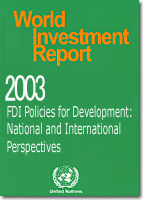|
Published by the United Nations Conference on Trade and Development - UNCTAD
WORLD INVESTMENT REPORT 2003
FDI Policies for Development: National and International Perspectives

The World Investment Report 2003 focuses on the foreign direct
investment (FDI) downturn, its reasons and the role of national policies
and international investment agreements (IIA) in attracting FDI to a
country and for a country to benefit from it.
Part One discusses the overall trends in FDI. FDI flows have dropped
drastically and no rebound is expected in 2003. The reasons for the
downturn are discussed from a global perspective, as well as by region -
developed countries, Africa, Asia and the Pacific, Latin America and the
Caribbean, and Central and Eastern Europe.
Part Two focuses on key issues that straddle national FDI policies
and international investment agreements with a view to bringing out the
development dimension. Special attention is given to the rise of IIAs,
the right to regulate, home country measures and corporate social
responsibility.
The report includes a statistical annex of over 100 pages.
Quick Links: | Press
Conference Opening Statements |
|
Table of contents - Preface - Acknowledgements
Overview
Overview in:
Spanish,
French
PART ONE
FDI falls again - unevenly
Chapter I
[PDF, 31pp., 2466KB]
FDI down 21% globally
A. The downturn continues
B. The unevenness of the downturn
C. Performance Index captures the downturn´s unevenness
D. Why the downturn?
E. Softening the impact
F. Towards mega blocks?
G. Prospects
Chapter II
[PDF, 49pp., 632KB]
Uneven performance across regions
A. Developing countries
B. Central and Eastern Europe
C. Developed countries
PART TWO
Enhancing the development dimension of the International Investment Agreement
INTERNATIONAL INVESTMENT AGREEMENTS
UNCTAD has been working on issues related to bilateral
and regional investment agreements for some time, focusing on
policy analysis and technical cooperation,a and involving a wide
range of countries. WIR03 draws on this experience.
With the number of treaties that address FDI proliferating,
issues relating to international investment agreements (IIAs)—
agreements that, in their entirety or in part, address investment
issues—have come to the forefront of international economic
debate.
Part Two of WIR03 seeks to throw light, from the
development perspective, on certain issues that arise in IIAs—
irrespective of the ongoing multilateral investment discussions.
Whether governments negotiate IIAs—and, if so, at what level
and for what purpose—is their sovereign decision. And whatever
the outcome of the investment discussions in the WTO, the issues
raised here remain important, precisely because of bilateral and
regional treaty-making.
a The results of this work are contained in various UNCTAD publications listed in
the references. For the coverage of technical cooperation, see UNCTAD 2003e.
Chapter III
[PDF, 19pp., 214KB]
Key national FDI policies and international investment
agreements
A. Key national FDI policies
B. The growth of IIAs
C. Features of IIAs at different levels
Chapter IV
[PDF, 47pp., 360KB]
Eight key issues: National Experiences and International
Approaches
A. Definition of investment
B. National treatment
C. Nationalization and expropriation
D. Dispute settlement
E. Performance requirements
F. Incentives
G. Transfer of technology
H. Competition policy
Chapter V
[PDF, 11pp., 187KB]
The importance of national policy space
The preceding analysis revealed that IIAs
need to accommodate different perspectives on the
policy priorities in the investment process. The
common goal, shared by all parties to IIAs, is to
increase the flows of FDI. In addition, home
countries (and their investors) seek transparency,
stability, predictability and security—and greater
market access. And host developing countries, for
their part, want to advance their development by
increasing the benefits from FDI. To do so, they
need to have enough flexibility to use a range of
development-oriented policies. In the final analysis,
IIAs have to be acceptable to all parties, many in
different development situations with widely
differing endowments. IIAs therefore need to strike
a mutually advantageous balance of rights and
obligations between the diverging interests and
priorities of various groups of countries.
A. Objectives of IIAs
B. Structure
C. Content
D. Implementation of IIAs
Chapter VI
[PDF, 19pp., 219KB]
Home countries and investors
A. Home country measures
B. Good corporate citizenship
References
Annexes
[PDF, 123pp., 657KB]
Selected UNCTAD publications on
Transnational Corporations and Foreign Direct Investment
Questionnaire
Book information:
UN Symbol: UNCTAD/WIR/2003
Sales no.: E.03.II.D.8
Date of publication: 04/09/03
ISBN: 92-1-112580-4
No. of pages: 322 pages
Price:
US$ 49 (Developed countries)
US$ 19 (Developing countries)
To order: Order form
|
|
|